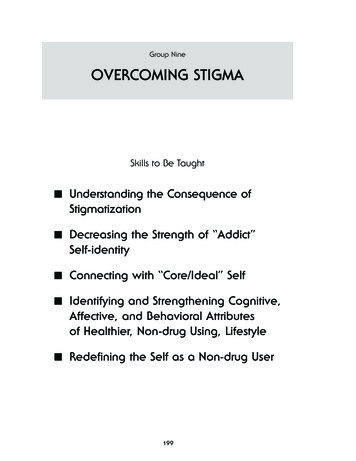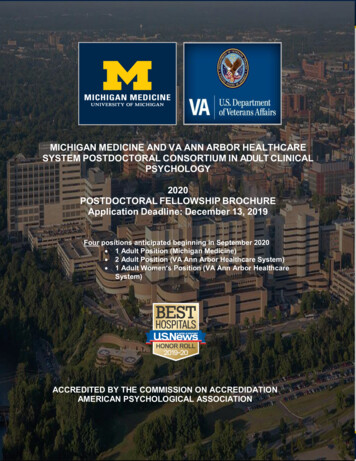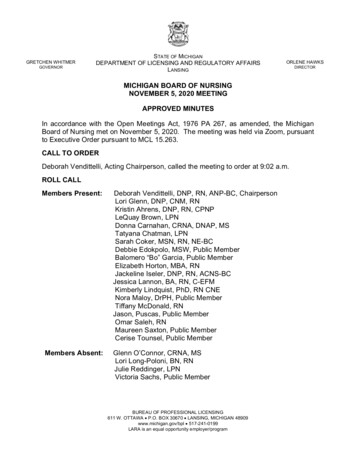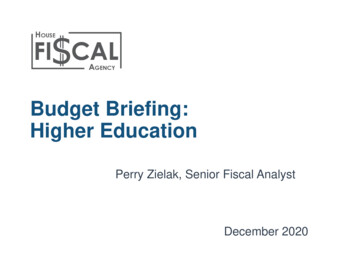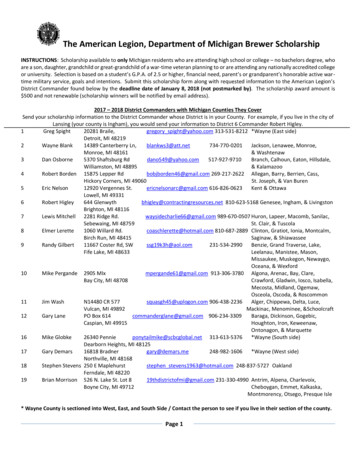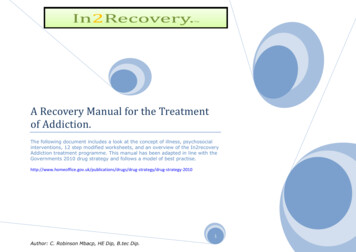
Transcription
COMBATINGSTIGMAWithin the Michigan Mental Health SystemA Toolkit for ChangeMichigan Department of Community HealthJune 2011
333“Our dream of the day whenstigma no longer exists, whenservices are available to all, andwhen every individual can lookforward to a happy and fulfillingfuture is within our reach.”-Rosalynn Carter
55Tableof Contents5TABLE OF CONTENTSDirector’s Remarks 6Toolkit Overview. 7Stigma Defined. 9Tools for Action.12Planning a Campaign within an Organization. 13Targeted Provider Roles . 15Promising Practices . 16Creating Teachable Moments. 23Life Stories . .25Evaluating Effectiveness. 32Evaluation Tools.33Additional Resources. 36Appendix A: Additional Definitions of Stigma . . .41Appendix B: Video Resources .42Appendix C: Examples of Anti-Stigma Initiatives 44International . .44National . . 48Appendix D: Evaluation Materials . .50Secret Shopper . . .51Appendix E: Attitudes, Beliefs, and Competencies for theRecovery-Oriented Professional .53Appendix F: Brochures– Targeted Provider Roles . .55Committee Membership . 75“Mental illness isnothing to beashamed of,but stigma andbias shame usall.”-Bill Clinton
Director’s Remarks666DIRECTOR’S REMARKS“We encouragelocal CMHSPs,providers, andadvocates at alllevels of themental healthsystem to use theresources in thistoolkit andpartner with thosethey support todevelopsuccessfulapproaches tocombating stigmawithin theirsystems."-Olga Dazzo,Director, MichiganDepartment ofCommunity HealthJune 2011Anti-Stigma Steering Committee ToolkitDirector‘s RemarksStigma toward mental illness is one of the leading reasonsindividuals with mental illness do not seek treatment for theirconditions. Unfortunately, individuals with mental illness identifymental health providers as one of the top groups by whom they feelstigmatized. Consequently, it is vital that as a mental health system,we ―look in the mirror,‖ start with ourselves, and make it a toppriority to acknowledge stigma and reduce it within our own ranksMDCH has made investments in the form of resources, guidanceand support, and in providing leadership to combat stigma. Thistoolkit is a product of that investment. It is designed to assist mentalhealth providers to combat stigma within the mental health systemand themselves.We encourage local CMHSPs, providers, and advocates at all levelsof the mental health system to use the resources in this toolkit andpartner with those they support to develop successful approaches tocombating stigma within their systems.
77ToolkitOverview7TOOLKIT OVERVIEWWhy the toolkit was created:Mental health providers are among the top two groups by whomindividuals with mental illness report feeling the most stigmatized(California Department of Mental Health 2010. Thorncroft, Brohan,Kassam, Lewis-Holmes 2008, MHCC 2008, CNMHC 2004. Brody2007). Despite this evidence, there are no known resources thatteach individuals with mental illness or providers how torecognize and combat stigma within the mental health system.This toolkit was designed to fill that niche.How to use the toolkit:This toolkit is a compilation of resources to help providers combatstigma within the mental health system. Use the resources in thefollowing order:First: Read the definition of stigma and the types of stigma outlinedin the Define Stigma subsection of the toolkit. This will provide acommon language and understanding as you use the anti-stigmamaterials in the toolkit.Second: Create a plan or anti-stigma campaign by following the 8steps in the Planning a Campaign within an Organization: Tools forAction section. While planning your campaign, look at examples ofother anti-stigma activities that are going on in Michigan (see thePromising Practices section) to get creative ideas. Incorporate whatyou think would work for your organization and ignore what youknow will not.Third: Look at the other materials in the Tools for Action section.These are educational materials that can be incorporated into yourcampaign as you see fit. The brochures provide printed informationtargeting specific provider roles. The Creating Teachable Momentsportion gives ideas on how to take stigmatizing situations and turnthem into educational ones. The Life Stories section provides reallife examples and discussion questions on how individuals withmental illness have encountered stigma within the mental healthsystem.These materials are excellent tools for trainings or meetings, but areadaptable to a variety of settings.IN THISSECTION Why atoolkit? How to usethe toolkit StigmaDefined Stigma Facts"As a profession,and moreimportantly, as asociety, we cannever beconsideredsuccessful untilwe can truthfullysay that stigmafor anyone with amental illness isnot a factor.”-Danis Russell,Chief Executive Officer,Genesee CountyCommunity Mental Health
Toolkit Overview888Fourth: When planning your campaign, be sure to include anevaluation plan. The toolkit includes a simple evaluation to assessthe effectiveness of the campaign. Review this to see if it will work foryour organization. If you choose to use this evaluation, determine atime when you will distribute the evaluation to providers throughoutyour organization, and when you will collect them. You can repeatthis process to measure the effect of the campaign over time.“Metaphor is asimple bridgeover thecomplexity, anddemystifying thebrain is a steptowards destigmatizingmental illness."If you choose not to use this evaluation, there are additionalevaluation resources in Appendix D of the toolkit. These evaluationsmay need to be revised to fit the needs of your organization.Fifth: DO NOT forget the video resources, websites, articles, andbooks in the Appendices. These can be effective, educational andeye-catching tools to use in you anti-stigma efforts.Sixth: Have fun! Remember the work you are doing is important andwill benefit others. There is so much room for creativity. Enjoy it!-Jane Pauley,JournalistDid You Know Stigma makes an impact on different segmentsof society.People with a mental illness suffer the most fromstigma (Corrigan & Kleinlein). In addition, peoplewho are involved in their lives also are impacted.Landlords, employers, healthcare professionals, lawenforcement agents, members of the legal system,family members, friends, and communities all areimpacted by the sense of public stigma. It oftendetermines if they will provide housing, employmentor other services to individuals with mental illness.Laura Waschull,MACMHB CreativeMinds traveling artshow
99ToolkitOverview9STIGMA DEFINEDWhat is stigma?“Stigma refers to attitudes and beliefsthat lead people to reject, avoid, or fearthose they perceive as being different.”- from the California Strategic Plan on Reducing MentalHealth Stigma and Discrimination (page 10)Types of StigmaIn our society, different forms of stigma are associated withdifferent groups of people, based on their gender, racial orethnic group, sexual orientation, religion, physical disability,etc. There are many different forms of stigma. You can finda list of alternative definitions of stigma in Appendix A of thistoolkit.Although it is important to consider stigma in its many forms,this toolkit focuses primarily on ―institutional stigma.‖―Public stigma” encompasses the attitudes and feelingsexpressed by many in the general public toward personsliving with mental health challenges or their familymembers.“Institutional stigma” occurs when negative attitudes andbehaviors about mental illness, including social,emotional, and behavioral problems, are incorporatedinto the policies, practices, and cultures of organizationsand social systems, such as education, health care, andemployment.“Self-stigma” occurs when individuals internalize thedisrespectful images that society, a community, or apeer group perpetuate, which may lead manyindividuals to refrain from seeking treatment for theirmental health conditions.”- from the California Strategic Plan on Reducing MentalHealth Stigma and Discrimination (page 10)“For too long thefear of mentalillness has beenprofoundlydestructive topeople’s lives. Infact, mentalillnesses are justas real as otherillnesses, andthey are like otherillnesses in mostways. Yet fear andstigma persist,resulting in lostopportunities forindividuals toseek treatmentand improve orrecover.”- from ―Mental Health: AReport of the SurgeonGeneral (1999)‖
Toolkit Overview101010Table 1. Comparing and contrasting the perspectives of stigma.Public Stigma"Stigma goes farbeyond the misuseof words andinformation. It isabout disrespect. . . .Our society tends tonot give the sameacceptance to braindisorders as we doto other organdisorders, say, hearttrouble. . .Stigmamust, and can, beexposed andovercome. Everyonemust know that it isnot their fault andthat it is OK to askfor help."- National MentalHealth REOTYPENegative beliefabout a kness)Negative beliefabout the ence)Negative beliefabout the self(e.g., characterweakness,incompetence)PREJUDICEAgreement withbelief and/ornegative emotionalreaction (e.g.,anger, fear)Negativeattitudesincorporate intoculture oforganizationAgreement withbelief, negativeemotionalreaction (e.g.,low self-esteem,low selfefficacy)DISCRIMINATIONBehavior responseto prejudice (e.g.,avoidance,withholdemployment andhousingopportunities,withhold help)Negativeattitudes andbehaviorsincorporated intopolices,practices, andcultures oforganization andsocial systemsBehaviorresponse toprejudice (e.g.,fails to pursuework andhousingopportunities)Corrigan P., Watson, A., (2002). Understanding the impact of stigma onpeople with mental illness. World Psychiatry, 1(1): 16-20
Toolkit1111Overview11Table 2. How does stigma relate to stereotypes, prejudice anddiscrimination?The effects of prejudice and discriminationPrejudice anddiscriminationexclude people withmental health andsubstance useproblems fromactivities that are opento other people.This limits people's ability to: get and keep a job get and keep a safe place to live get health care (including treatment forsubstance use and mental healthproblems) and other support be accepted by their family, friends andcommunity find and make friends or have other longterm relationships take part in social activitiesPrejudice anddiscrimination oftenbecome internalizedby people with mentalhealth and substanceuse problems.This leads them to: believe the negative things that otherpeople and the media say about them(self-stigma) have lower self-esteem because theyfeel guilt and shame"Stigma isprejudicewrapped inshame, born ofour ignorance,and fed by ourfear."-Barbara Lawton,Former LieutenantGovernor of WisconsinAs a result:Prejudice anddiscrimination they avoid getting the help they needcontribute to people their mental health or substance usewith mental health andproblems are less likely to decrease orsubstance usego awayproblems keepingtheir problems asecret.(Corrigan P., Watson, A., (2002). Understanding the impact of stigma onpeople with mental illness. World Psychiatry, 1(1): 16-20)Why Should I Care About Stigma?Did you know . . . . . formany people with mental illness, stigma is a barrier togetting treatment and support.Melissa Brown,MACMHB CreativeMinds traveling artshow
Tools For Action121212IN THISSECTION Planorganizationalcampaign TargetedProvider Roles Examples ofBest Practices Life stories:Vignettes ofstigma withinthe mentalhealth systemTOOLS FOR ACTIONThis section provides tools to create an effective anti-stigmacampaign within your organization. It will help you plan thecampaign, identify your target audience, and provide you withexamples of anti-stigma activities that have been successful inother places in Michigan.Remember, there are no known campaigns that have specificallyfocused on providers within the mental health system, so thesetools may need to be modified to reach the need of yourorganization.“After becoming aCertified PeerSupportSpecialist, Ibecame a lightthat shines intothe dark world ofstigma, a lightthat freely shineson humanity.”Did You Know -Richard Mott,Certified Peer SupportSpecialist Stigma affects family members of individualswith mental illness?This is sometimes called courtesy stigma, or whenfamily members & those associated with persons withmental illness experience avoidance by others becauseof stigma. (http://www.facingstigma.org/fs v5/facts/stigma.html)
Tools For Action131313PLANNING A CAMPAIGN WITHINAN ORGANIZATIONThis section identifies resources to help define best approaches tostigma campaign planning and apply them to stigma within themental health system.STEP 1. Secure approval and promotion from upper management.Let them know the purpose of the campaign and thepositive impact it will have on empowering individuals withmental illness.STEP 2. Form a team of individuals to be change agents in theorganization and champion the cause, such as customerservices, marketing, and training.STEP 3. The team will:Develop a plan of action to change the institutional culture,such as providing incentives, communication, trainings,contests, and videos for staff and persons receiving mentalhealth services that: Reinforce the message Recognize ways to combat stigma Evaluate the results through: ―Secret Shoppers‖ (See Appendix D) Pre/post test Feedback and focus groups, dependent onaudience (such as primary/secondaryconsumers, clinicians, case managers)STEP 4. Determine your audience Target a certain program Find out if there is a training department Decide who would be the most receptiveSTEP 5. Prioritize content, frequency and delivery method (who,what, how often) Content to fit the audience you have identifiedFrequency of events that reoccur such as monthlymeetingsDelivery method to fit the event―Providers are ina key position tomake a difference.Their attitudescan either help orhinder therecovery process.Their influencedirectly impactsthe way a personconceptualizestheir recoveryjourney.”-Lori Ashcraft,Executive Director ofthe RecoveryOpportunity Center atRecovery Innovations
Tools For Action141414PLANNING A CAMPAIGN WITHINAN ORGANIZATION"I think that themovement towardconsumerism andconsumers involvedin the mental healthsystem has been asinvigorating formental healthprofessionals as ithas been for theconsumers. . . mostof them didn’t getinto mental healthbecause they wantedto see peopleinstitutionalized.Most of them got intomental healthbecause they wantedto see peopleempowered."Jean Dukarski, CertifiedPeer Support Specialist,JIMHOMatthew Craig,MACMHB CreativeMinds traveling artshowSTEP 6. Be flexible, make changes as needed.Remember, no plan ever perfectly survives itsimplementation.STEP 7. Use the documents in toolkit. Identify provider roles thatare missing, and create information resourcesaccordingly. Utilize and reproduce brochures in toolkit.Use the video resources included in Appendix B.Don‘t be restricted by what is in the toolkit. You knowyour audience best!STEP 8. Look through examples of best practices and determinewhat should be included. Find additional resources asneeded.
1515ToolsFor Action15TARGETED PROVIDER ROLES:[BROCHURES]Every position within the mental health field can have a affect onthe experience of someone receiving services. It doesn‘t matter ifyou meet face to face with individuals with mental illness, or if youwork behind the scenes. Everyone plays a part. This toolkitprovides informational brochures for nine provider roles that canbe found in most mental health agencies. They include: Administrators Customer Service Representatives Finance Directors Front Line Workers Human Resource Professionals Peer Support Specialists Program Supervisors Psychiatrists Quality Improvement ProfessionalsThese brochures contain information unique to each role that canshow professionals what they can do to stop stigma within theirprofessional role. They contain facts and examples of stigma.If there are provider roles that you see are missing from thistoolkit, feel free to create your own brochure using the templatefound in the electronic version of this toolkit found atwww.mirecovery.org.“Every positionwithin the mentalhealth field canhave a profoundimpact on theexperience ofsomeonereceivingservices.”-Michigan Anti-StigmaSteering Committee
Tools For Action161616PROMISING PRACTICESThe Dream of RecoveryI have a dream that oneday boys and girls, menand women, will be ableto get medical attentionfor their mental illnesswhether they are rich orpoor.Anti-stigma initiatives have been conducted for many years. Mostinitiatives have targeted the general community, but contain ideasthat may work for your organization. Learn from these examplesand take components from them that would work in your area.Additional ideas may be found in Appendix C.Stigma will exist nomore!Those who need medication will have it readilyavailable to them.No more lack of medications or manic reactions.How do I identify stigma in myworkplace? Listen to language used to describeindividuals with mental illness. How often doproviders around you refer to the people theyserve as a person with mental illness not amentally ill person, or as simply MI or DD? How often do you hear persons receivingmental health services referred to as difficult,non-compliant, crazy, insane or retarded? Have all staff at all levels within your agencyparticipated in awareness programs related tothe stigma associated with mental illness? Do all company policies and culture reflect anaccepting environment for individuals withmental illness, and are they enforced? What structural barriers are there thatseparate provider amenities from consumeramenities; for example, separate bathroomsfor individuals receiving services andproviders?The view of the future willbe positive and true.Men and women who areassisted by the few.The few who help manyto stay the course, thecourse of Recovery .Via the tested journey - Ajourney on the Path ofRecovery.- Patricia Jefferson, CertifiedPeer Support Specialist, NewCenter Community MentalHealth Services, DetroitWayne County, Michigan
1717ToolsFor Action17TIPS TO INDIVIDUALLYCONFRONT STIGMA WITHINTHE MENTAL HEALTH SYSTEMFor many people, confrontation is difficult and/or uncomfortableespecially when approaching someone about offensive or hurtfulbehavior. It can be even more difficult if that person works for youor is your supervisor or employer.The way to approach a situation where you witness stigma, or area victim of stigmatizing behavior depends largely on individualcircumstances. The following are some general suggestions tohelp you help yourself and others confront stigmatizing behaviors.First: Consider the various reasons someone might stigmatizeanother person. This will help you know how you can react.Within the mental health system, most people are well-intentionedin their relationships with people they work with. However, stigmadoes exist and may occur because of one or more of the followingreasons: Power or Position (of the person stigmatizing or the personbeing stigmatized). Someone tries to use organizationalposition or personal power for his or her own selfish goals.Ignorance. Rules change and some people truly don'tunderstand that their actions are hurtful.Intentional. Some people take out their own frustrations onothers by intentionally causing pain or discomfort.Rules are not enforced (some organizations have rulesagainst stigma and/or discrimination that are not enforced).When rules aren't enforced, people assume they don't reallymatter.Absence of appropriate consequences to hurtful behaviorThe culture of the workplace supports itFear of people they don‘t understand or who are different“We in the mentalhealth field have alot of educating todo.”-Susan Speck,Certified Peer SupportSpecialist,Genesee CountyCommunity MentalHealth
Tools For Action181818TIPS TO INDIVIDUALLYCONFRONT STIGMA WITHINTHE MENTAL HEALTH SYSTEMSecond: Determine how to REACT“I am a hope giverand a hopereceiver.”-Sherri Rushman,Author of CatchingHope,www.catchinghope.comRecognize that stigmatizing behavior should not be normal oracceptable anywhere.Explain organization and agency rules against stigmatizingbehaviors.Act to report stigma if you or someone you know is a victim.Care for those being stigmatized and the stigmatizer withoutaccepting the stigmatizing behavior.Turn to key friends and advisors who also believe thatstigmatizing behaviors are wrong.One way to react is to realize that stigma is a form ofdiscrimination, and can often be addressed using the sameprotocols organizations have in place for discrimination orharassment. Obtain your organization‘s policy on harassment tosee what it entails. ―They are asked to stop by a coworker, subordinate, superioror colleague.‖―They learned about discriminatory harassment behaviors,regulations, and repercussions of discriminatory harassmenttraining.‖ (Quick Knowledge Discriminatory HarassmentTraining for Managers)Strategies and Examples: How to approach someone who isstigmatizing and what to sayHumor: Humor can dispel some of the tension that comes withconfrontation. It can also disarm a person who is potentially goingto become aggressive or confrontational. This comes naturally tosome, and not to others. If this is your strength, embrace it.Remember:"Laughter is the most potent, constructive force fordiffusing . . . tension. If you can point out what ishumorous or absurd about a situation orconfrontation, you will be guaranteed the upperhand."-Mark H. McCormick
1919ToolsFor Action19TIPS TO INDIVIDUALLYCONFRONT STIGMA WITHINTHE MENTAL HEALTH SYSTEMSelf-Talk: To prepare yourself for the confrontation, practice whatyou are going to say and give yourself words of encouragement.Role play possible reactions of the person you will talk to. Includeboth positive and negative reactions.―I will let them know how (fill in specificbehavior) was stigmatizing towards me or toward anothercolleague or individual receiving mental health services.He/she may react like this . If thathappens I will .Tell yourself ―I can do it.‖ ―What I am doing is right.‖ ―I havethe support of my supervisor, co-workers and organizationpolicy.‖Assert Yourself: Act on what you know is right, armed with thetools in this toolkit to help you. Be frank, and use ―I‖ language.―I felt stigmatized when you , (or whenhappened.) Will you please stop?‖―I noticed that this consumer or colleague felt this whenyou . Did you know that?‖Avoid confrontation if you know it will cause more damage thangood, but be sure to seek help from a supervisor or other trustedperson to help you resolve the situation!“I used to getfired because ofmy disability. NowI have a jobbecause of mydisability.”-Joann McCann,Certified Peer SupportSpecialist,Genesee CountyCommunity MentalHealth
Tools For Action202020PROMISING PRACTICES: WHAT’SGOING ON AROUND US“We contribute tothe stigma ofmental illnesswhen we fail torecognize and talkabout mentalillnesses as wewould any otherillness.”-Paul Ippel,Executive Director,Network 180The Northern Lakes CMH Photobiography Project helps individualswith mental illness write recovery stories which are illustrated withphotographs taken by individuals with mental illness using disposablecameras. The stories are made into posters which are displayedthroughout the CMH offices (and the community), providing inspirationto all that recovery is not only possible, but to be expected. Theseposters have positively influenced internal system stigma by providingthe opportunity for all who view them to see the people who receiveservices as individuals with hopes, dreams, and a great deal to offer.Washtenaw Community Health Organization Speakers Bureau ismade up of individuals living with mental illness. Some are receivingservices and some are employed in the system as peer supportspecialists, case managers, and administration. The presence ofspeakers who work in the system impacts institutional stigma byshowing others working in the system that people with mental illnessare not just those they see as cases, patients and individuals withmental illness, but also those they work with. The bravery displayed bythese speakers decreases stigma not only in the work place, butbranches out to those we serve.While the majority of speaking engagements take place at high schooland university psychology classes, speakers are branching out tocommunity organizations, Resident Advisors in collegedorms and places of worship.The Community Network Services Anti-StigmaProgram. In Oakland County, Peer Educators havetaken the lead in the development, marketing, andpresentation of an award-winning communityeducation program. The Peers have been a source ofencouragement and continue to expand their influenceand outreach each year. As leaders in the field ofpeer-led initiatives, the CNS Anti-Stigma Team hassucceeded in reaching over 20,000 people around thecountry with their unique brand of community education.Jennifer Leonard,MACMHB CreativeMinds traveling artshowCNS accomplishments include a website,(http://www.cnsantistigmaprogram.org/), creation andproduction of the award winning video, ―Did You Know?,‖a documentary that recently aired on PBS, about mentalhealth stigma and its effects on people and their families;creation and production of ‖The Stomp‖ a monthly Enewsletter with a circulation of over 1500 subscribers, aswell as receiving national, state and local awards for theirwork.
2121ToolsFor ActionPROMISING PRACTICES: WHAT’SGOING ON AROUND USI Come with this Head — Detroit-Wayne County CommunityMental Health Agency.The ―I Come with this Head‖ poster presentation was designed tocounter the stigma that says people with psychiatric disabilitieshave limited abilities. The inspiration for this display came from amember of the Detroit Wayne County Community Mental HealthAgency‘s Community Planning Council Recovery Subcommitteewho described it this way: ―people are not just heads that comerolling into a doctor‘s office off the street, they are wholeindividuals with full lives.‖This unique display of posters depicts the lives of people inrecovery from various backgrounds. Stigma is an issue of socialjustice. By sharing a more complete picture of these individuals,we in effect assert their humanity. It is our goal to move oursystem and society beyond the blatant oppression of definingpeople by the condition(s) they have by counteringDespair with HopeDereliction with ResponsibilityDiscrimination with RespectDetachment with Community/Peer SupportDeficit views with Strength viewsDogmatism with Non-linear approachDisease models with Holistic modelsDisenfranchisement with EmpowermentDehumanizing with Individualized and Person-centerednessDirectives with Self-direction―It‘s Everybody‘s Business,‖The CPC Recovery Subcommittee21"Right now thechange that’sgoing on now inthe mental healthsystem is as big ajump as whencommunitymental health firststarted. . . . Weneed people inthe system,leaders of thesystem, that treatus as humanbeings and wefeel better aboutourselves. Wehave self esteemand we learn topass it on toothers."-Gerald Butler,Certified Peer SupportSpecialist
Tools For Action222222PROMISING PRACTICES: WHAT’SGOING ON AROUND USMental Health Foundation, Kent CountyLive Laugh Love: Educating our Youth About Mental Health.A recent study doneby Network 180 (KentCounty) showed thatone of the fourbarriers to treatmentwas stigma.-Mental HealthFoundationLive Laugh Love (LLL): Educating Our Youth about Mental Health is aprogram that has impact on teens, parents and educators. This is ahands-on, interactive curriculum focusing on mental health, mentalillness, and stigma. LLL directly addresses stigma. A recent studydone by Network 180 showed that one of the four barriers totreatment was stigma. By educating about stigma and mental illness itincreases awareness, thereby breaking the barriers to seeking help,and increasing willingness to seek services/treatment. LLL teachesindividuals that there is access to treatment that treatment isaffordable, and that recovery is possible.Stomp Out Stigma: Walk for Mental HealthThis is an annual event designed to raise awareness on the stigmaassociated with mental illness. Planned collaboratively with andsponsored by local mental health service providers, the annual StompOut Stigma – Walk for Mental Health is held in May in conjunctionwith National Mental Health Month. The impact is far reaching and isfelt with appreciation from walkers from all over west Michigan.People who have been directly affected by a loss of a loved onethrough suicide, as well as people living with mental health conditionsand their family members all come together to walk in support of oneanother.Shining ThroughThe Mental Health Foundation annual Shining Through Art Show &Auction spotlights the artistic talents of local artists who havepersonally suffered from bi-polar disorder, depression, anxietydisorders, schizophrenia and other types of treatable medicalconditions. Their participation in the event demonstrates that theyhave either recovered or are managing their illnesses in much thesame way one would
7 Toolkit Overview IN THIS SECTION Why a toolkit? How to use the toolkit Stigma Defined Stigma Facts TOOLKIT OVERVIEW Why the toolkit was created: Mental health providers are among the top two groups by whom individuals with mental illness report feeling the most stigmatized (California Department of
